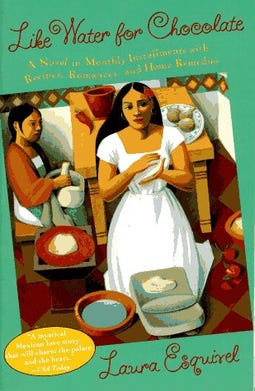Sometimes I plan what I read, sometimes I don’t. The reason for the latter is, most often than not, because I visited a bookstore unexpectedly and chanced upon a bargain book. This was definitely the case on why I picked up Like Water for Chocolate by Laura Esquivel. It was just sitting there on the shelf with a price tag of only 87 pesos (roughly two dollars), so I had to pick it up.
Magical realism through food
The novel centers on Tita and her forbidden romance with Pedro because of a Mexican tradition wherein the youngest daughter of the family is not allowed to marry until the death of the matriarch. Pedro eventually married another woman that’s close to Tita but both of them still yearns to be with each other. We follow Tita and her life after Pedro’s marriage, her several heartbreaks, and her claim for independence against her strong-willed and tradition-bound mother. Throughout the novel, we read about Mexican food and culture which are both driving forces behind the story.
Tita is the main cook of the family and prepares most of the meals, whether it's for daily meals or a feast for a celebration. She uses food to express her emotions (often repressed ones) which serves as a medium and transmits a weird reaction to people who eat her cooking. In one scene, Tita was so heart broken and accidently dropped her tears in a cake she was making. Everyone who ate the cake was flooded with a great wave of longing that turned into frustration and then into collective vomiting. In another scene, Tita cooked a meal with rose petals from a bouquet that Pedro gave her. Because of the bouquet, Tita and Pedro’s sexual passion was reignited and when her sister ate the dish, it induced her into a lustful state where she ran around the house and away from town naked. This isn't even the most ridiculous thing that happened in the book. But I will stop there. I enjoyed reading everything despite questioning why and how weird things happen. The touch of magical realism through food made this book a delight to read.
Heat and fire
Fire is also a central theme in this book which is not surprising since it is a catalyst for cooking food. Fire represents passion and desire in the book. With that, let me say that this is a very sensual book and is not suited for younger children. Fire also symbolizes Tita's inner "fire" which she struggles to nurture after encountering several heart breaks. John, one of the central characters of the book, helps Tita bring back her inner fire.
“Each of us is born with a box of matches inside us but we can't strike them all by ourselves; we need oxygen and a candle to help. In this case, the oxygen for example, would come from the breath of the person you love; the candle would be any kind of food, music, caress, word, or sound that engenders the explosion that lights one of the matches. For a moment we are dazzled by an intense emotion. A pleasant warmth grows within us, fading slowly as time goes by, until a new explosion comes along to revive it. Each person has to discover what will set off those explosions in order to live, since the combustion that occurs when one of them is ignited is what nourishes the soul. That fire, in short, is its food. If one doesn't find out in time what will set off these explosions, the box of matches dampens, and not a single match will ever be lighted.”
Book structure
The novel is uniquely structured. Each chapter starts with a month and a dish. The next page lists the ingredients and the chapter begins with how to prepare the said dish. From there, the author relates the preparation of the said dish to the current narration. For example, the January chapter (Christmas rolls recipe) starts with a reminder to chop the onion for the dish finely. The narrator tells us that once you start chopping the onion, you cry and can't stop crying. This leads her to telling us she is especially sensitive to onions like her great-aunt, Tita, who came out of her mother's belly early because her mother was chopping onions one day and Tita was wailing so hard while inside the womb that it brought on an early labor. Tita was born right there and then when her mother was chopping onions. This transition from narrating how to prepare a recipe to a the chapter's content is evident all through out the book. Sometimes a secondary recipe is also introduced in the chapter and the cooking instructions are weaved in between the narration. This infusion reminds me a lot of The Brief and Wondrous Life of Oscar Wao by Junot Diaz.
Like Water for Chocolate is such a short read but has so many layers. You can read it as a romance book, or a historical novel since this book was set during the Mexican Revolution, or a book about Mexico’s traditional values versus modern moralities.
To anybody who has read this book already, did you agree with who Tita ended up with?
More like this: One Hundred Years of Solitude
What I’m reading this week
This book is another case of an unplanned read. I had accidentally been collecting Vintage Red editions and when I saw I Who Have Never Known Men by Jacqueline Harpman in a bookstore, I just had to buy it. As of this writing I am 50 pages in and I am loving it. I also just finished the 600-page book, The Amazing Adventures of Kavalier & Clay. I loved it! Will talk about it soon.
In case you missed this..
Everything in this newsletter is free for now. And so, every open, like, comment, or restack means a lot to me and I thank you all for your support. If you’d like to further support me, buy me a coffee so that I can continue this work.









Thank you for this, Jam! A colleague mentioned this book earlier in the week and I hadn't heard of it—and now I've serendipitously found your review!
Tbh, no, I didn’t really like that she ended up with Pedro 🥹 but then that epic wouldn’t have happened with John! And great analysis on the fire & heat and how it plays as an important element in the novel in multiple forms: in passion, in cooking, and in soul.